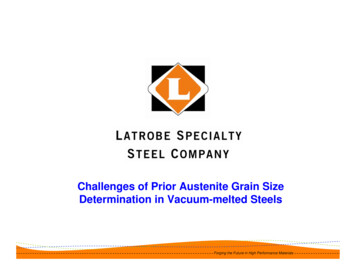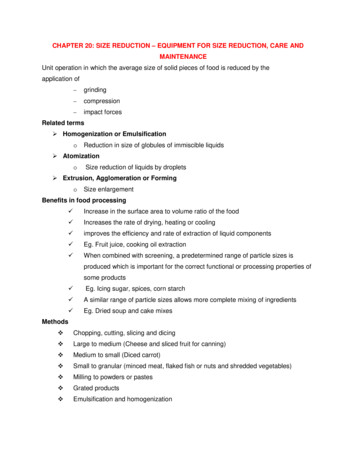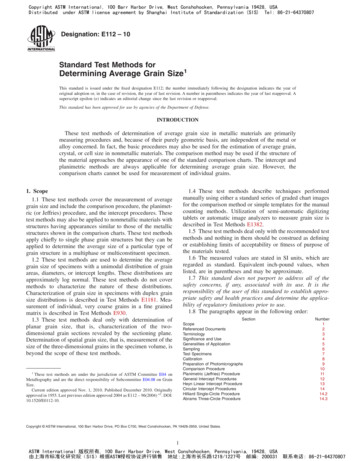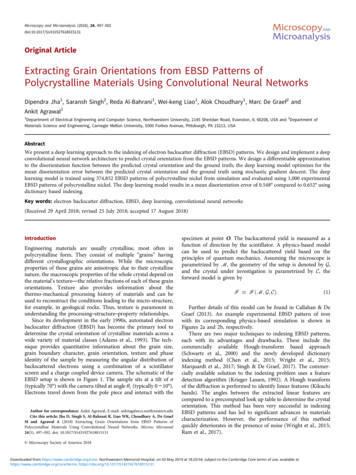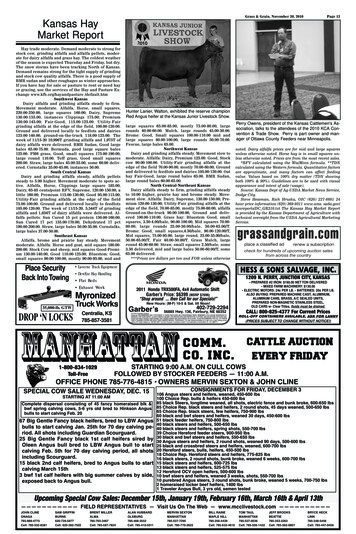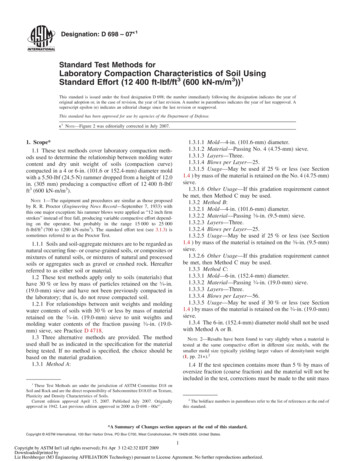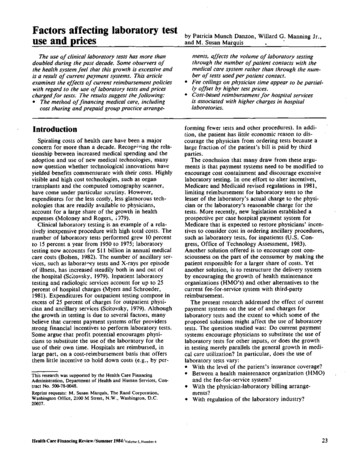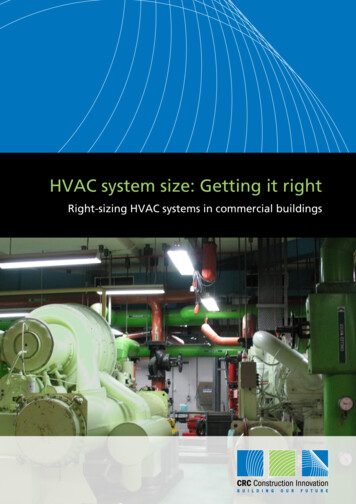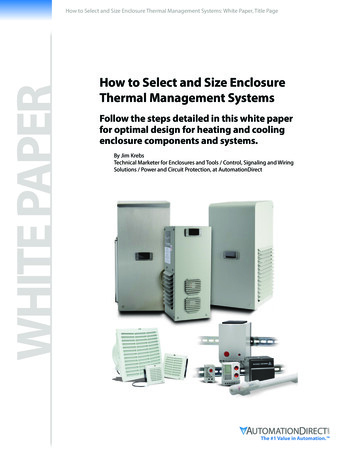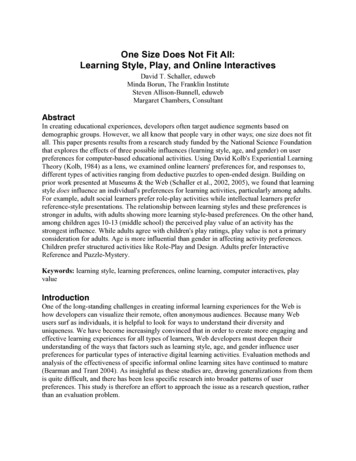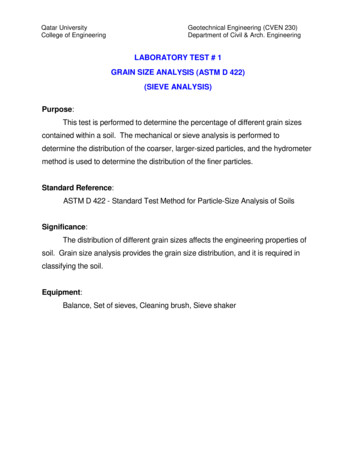
Transcription
Qatar UniversityCollege of EngineeringGeotechnical Engineering (CVEN 230)Department of Civil & Arch. EngineeringLABORATORY TEST # 1GRAIN SIZE ANALYSIS (ASTM D 422)(SIEVE ANALYSIS)Purpose:This test is performed to determine the percentage of different grain sizescontained within a soil. The mechanical or sieve analysis is performed todetermine the distribution of the coarser, larger-sized particles, and the hydrometermethod is used to determine the distribution of the finer particles.Standard Reference:ASTM D 422 - Standard Test Method for Particle-Size Analysis of SoilsSignificance:The distribution of different grain sizes affects the engineering properties ofsoil. Grain size analysis provides the grain size distribution, and it is required inclassifying the soil.Equipment:Balance, Set of sieves, Cleaning brush, Sieve shaker
Qatar UniversityCollege of EngineeringGeotechnical Engineering (CVEN 230)Department of Civil & Arch. EngineeringTest Procedure:Sieve Analysis:(1)Write down the weight of each sieve as well as the bottom pan to beused in the analysis.(2)Record the weight of the given dry soil sample.(3)Make sure that all the sieves are clean, and assemble them in theascending order of sieve numbers (#4 sieve at top and #200 sieve atbottom). Place the pan below #200 sieve. Carefully pour the soilsample into the top sieve and place the cap over it.(4)Place the sieve stack in the mechanical shaker and shake for 10minutes.(5)Remove the stack from the shaker and carefully weigh and record theweight of each sieve with its retained soil. In addition, remember toweigh and record the weight of the bottom pan with its retained finesoil.Data Analysis:Sieve Analysis:(1)Obtain the mass of soil retained on each sieve by subtracting theweight of the empty sieve from the mass of the sieve retained soil,and record this mass as the weight retained on the data sheet. Thesum of these retained masses should be approximately equals theinitial mass of the soil sample. A loss of more than two percent isunsatisfactory.
Qatar UniversityCollege of Engineering(2)Geotechnical Engineering (CVEN 230)Department of Civil & Arch. EngineeringCalculate the percent retained on each sieve by dividing the weightretained on each sieve by the original sample mass.(3)Calculate the percent passing (or percent finer) by starting with 100percent and subtracting the percent retained on each sieve as acumulative procedure.For example: Total mass 500 gMass retained on No. 4 sieve 9.7 gMass retained on No. 10 sieve 39.5 gFor the No.4 sieve:Quantity passing Total mass - Mass retained 500 - 9.7 490.3 gThe percent retained is calculated as;% retained Mass retained/Total mass (9.7/500) X 100 1.9 %From this, the % passing 100 - 1.9 98.1 %For the No. 10 sieve:Quantity passing Mass arriving - Mass retained 490.3 - 39.5 450.8 g% Retained (39.5/500) X 100 7.9 %% Passing 100 - 1.9 - 7.9 90.2 %(Alternatively, use % passing % Arriving - % RetainedFor No. 10 sieve 98.1 - 7.9 90.2 %)(4)Make a semilogarithmic plot of grain size vs. percent finer.
Qatar UniversityCollege of Engineering(5)SieveNumberGeotechnical Engineering (CVEN 230)Department of Civil & Arch. EngineeringCompute Cc and Cu for the soil.Diameter(mm)Mass ofEmptySieve (g)Mass ofSieve SoilRetained (g)410204060140200PanTotal Weight SoilRetained(g)PercentRetainedPercentPassing
Qatar UniversityCollege of EngineeringGeotechnical Engineering (CVEN 230)Department of Civil & Arch. EngineeringLABORATORY TEST # 2GRAIN SIZE ANALYSIS (ASTM D 422)(HYDROMETER ANALYSIS)Purpose:This test is performed to determine the percentage of different grain sizescontained within a soil. The hydrometer method is used to determine thedistribution of the finer particles.Standard Reference:ASTM D 422 - Standard Test Method for Particle-Size Analysis of SoilsSignificance:The distribution of different grain sizes affects the engineering properties ofsoil. Grain size analysis provides the grain size distribution, and it is required inclassifying the soil.Equipment:Mixer (blender), 152H Hydrometer, Sedimentation cylinder, Control cylinder,Thermometer, Beaker, Timing device.
Qatar UniversityCollege of EngineeringGeotechnical Engineering (CVEN 230)Department of Civil & Arch. EngineeringTest Procedure:Hydrometer Analysis:(1)Take the fine soil from the bottom pan of the sieve set, place it into abeaker, and add 125 mL of the dispersing agent (sodiumhexametaphosphate (40 g/L)) solution. Stir the mixture until the soil isthoroughly wet. Let the soil soak for at least ten minutes.(2)While the soil is soaking, add 125mL of dispersing agent into thecontrol cylinder and fill it with distilled water to the mark. Take thereading at the top of the meniscus formed by the hydrometerstem and the control solution. A reading less than zero isrecorded as a negative (-) correction and a reading between zeroand sixty is recorded as a positive ( ) correction. This reading iscalled the zero correction. The meniscus correction is thedifference between the top of the meniscus and the level of thesolution in the control jar (Usually about 1).Shake the control cylinder in such a way that the contents are mixedthoroughly. Insert the hydrometer and thermometer into the controlcylinder and note the zero correction and temperature respectively.(3)Transfer the soil slurry into a mixer by adding more distilled water, ifnecessary, until mixing cup is at least half full. Then mix the solutionfor a period of two minutes.(4)Immediately transfer the soil slurry into the empty sedimentationcylinder. Add distilled water up to the mark.(5)Cover the open end of the cylinder with a stopper and secure it with
Qatar UniversityCollege of EngineeringGeotechnical Engineering (CVEN 230)Department of Civil & Arch. Engineeringthe palm of your hand. Then turn the cylinder upside down and backupright for a period of one minute. (The cylinder should be invertedapproximately 30 times during the minute.)(6)Set the cylinder down and record the time. Remove the stopper fromthe cylinder. After an elapsed time of one minute and forty seconds,very slowly and carefully insert the hydrometer for the first reading.(Note: It should take about ten seconds to insert or remove thehydrometer to minimize any disturbance, and the release of thehydrometer should be made as close to the reading depth as possibleto avoid excessive bobbing).(7)The reading is taken by observing the top of the meniscus formed bythe suspension and the hydrometer stem. The hydrometer is removedslowly and placed back into the control cylinder. Very gently spin it incontrol cylinder to remove any particles that may have adhered.(8)Take hydrometer readings after elapsed time of 2 and 5, 8, 15, 30, 60minutes and 24 hour.
Qatar UniversityCollege of EngineeringGeotechnical Engineering (CVEN 230)Department of Civil & Arch. EngineeringData Analysis:Hydrometer Analysis:(1)Apply meniscus correction to the actual hydrometer reading.(2)From Table 1, obtain the effective hydrometer depth L in cm (formeniscus corrected reading).(3)For known Gs of the soil (if not known, assume 2.65 for this labpurpose), obtain the value of K from Table 2.(4)Calculate the equivalent particle diameter by using the followingformula:𝐷 𝐾 𝐿𝑡Where t is in minutes, and D is given in mm.(5)Determine the temperature correction CT from Table 3.(6)Determine correction factor “a” from Table 4 using Gs.(7)Calculate corrected hydrometer reading as follows:Rc RACTUAL - zero correction CT(8)Calculate percent finer as follows:𝑃 𝑅𝑐 𝑎𝑤𝑆Where WS is the weight of the soil sample in grams.
Qatar UniversityCollege of Engineering(9)Geotechnical Engineering (CVEN 230)Department of Civil & Arch. EngineeringAdjusted percent fines as follows:𝑃𝐴 𝑃 𝐹200100F200 % finer of #200 sieve as a percent(10)Plot the grain size curve D versus the adjusted percent finer on thesemilogarithmic sheet.
Qatar UniversityCollege of EngineeringGeotechnical Engineering (CVEN 230)Department of Civil & Arch. EngineeringTable 1. Values of Effective Depth Based on Hydrometer and SedimentationCylinder of Specific SizesHydrometer 151HActualEffectiveHydrometerDepth, L 5161718192021222324252627282930Hydrometer 152HActualEffectiveHydrometerDepth, L tiveDepth, L .5
Qatar UniversityCollege of EngineeringGeotechnical Engineering (CVEN 230)Department of Civil & Arch. EngineeringTable 2. Values of k for Use in Equation for Computing Diameter of Particle inHydrometer AnalysisTemperatureoCSpecific Gravity of Soil 011750.011620.01149
Qatar UniversityCollege of EngineeringGeotechnical Engineering (CVEN 230)Department of Civil & Arch. EngineeringTable 3. Temperature Correction Factors CTTemperature factor -0.50-0.300.00 0.20 0.40 0.70 1.00 1.30 1.65 2.00 2.50 3.05 3.80Table 4. Correction Factors a for Unit Weight of SolidsUnit Weight ofSoil tionfactora0.960.970.980.991.001.011.021.04
Qatar UniversityCollege of EngineeringGeotechnical Engineering (CVEN 230)Department of Civil & Arch. EngineeringLABORATORY TEST # 3ATTERBERG LIMITS (ASTM D 4318)(LIQUID LIMIT TEST)Purpose:This lab is performed to determine the plastic and liquid limits of a finegrained soil. The liquid limit (LL) is arbitrarily defined as the water content, inpercent, at which a part of soil in a standard cup and cut by a groove of standarddimensions will flow together at the base of the groove for a distance of 13 mm (1/2in.) when subjected to 25 shocks from the cup being dropped 10 mm in a standardliquid limit apparatus operated at a rate of two shocks per second.Standard Reference:ASTM D 4318 - Standard Test Method for Liquid Limit, Plastic Limit, andPlasticity Index of SoilsSignificance:The Swedish soil scientist Albert Atterberg originally defined seven “limits ofconsistency” to classify fine-grained soils, but in current engineering practice onlytwo of the limits, the liquid and plastic limits, are commonly used. (A third limit,called the shrinkage limit, is used occasionally.) The Atterberg limits are based onthe moisture content of the soil. The liquid limit is the moisture content that defineswhere the soil changes from a plastic to a viscous fluid state. The shrinkage limitis the moisture content that defines where the soil volume will not reduce further ifthe moisture content is reduced.
Qatar UniversityCollege of EngineeringGeotechnical Engineering (CVEN 230)Department of Civil & Arch. EngineeringA wide variety of soil engineering properties have been correlated to the liquid andplastic limits, and these Atterberg limits are also used to classify a fine-grained soilaccording to the Unified Soil Classification system or AASHTO system.Equipment:Liquid limit device, Porcelain (evaporating) dish, Flat grooving tool with gage,Eight moisture cans, Balance, Spatula, Wash bottle filled with distilled water, Dryingoven set at 105 C.Test Procedure:Liquid Limit:(1)Take roughly 3/4 of the soil and place it into the porcelain dish.Assume that the soil was previously passed though a No. 40 sieve,air-dried, and then pulverized. Thoroughly mix the soil with a smallamount of distilled water until it appears as a smooth uniform paste.Cover the dish with cellophane to prevent moisture from escaping.(2)Weigh four of the empty moisture cans with their lids, and record therespective weights and can numbers on the data sheet.(3)Adjust the liquid limit apparatus by checking the height of drop of thecup. The point on the cup that comes in contact with the base shouldrise to a height of 10 mm. The block on the end of the grooving tool is
Qatar UniversityCollege of EngineeringGeotechnical Engineering (CVEN 230)Department of Civil & Arch. Engineering10 mm high and should be used as a gage. Practice using the cupand determine the correct rate to rotate the crank so that the cupdrops approximately two times per second.(4)Place a portion of the previously mixed soil into the cup of the liquidlimit apparatus at the point where the cup rests on the base. Squeezethe soil down to eliminate air pockets and spread it into the cup to adepth of about 10 mm at its deepest point. The soil pat should forman approximately horizontal sur
GRAIN SIZE ANALYSIS (ASTM D 422) (SIEVE ANALYSIS) Purpose: This test is performed to determine the percentage of different grain sizes contained within a soil. The
